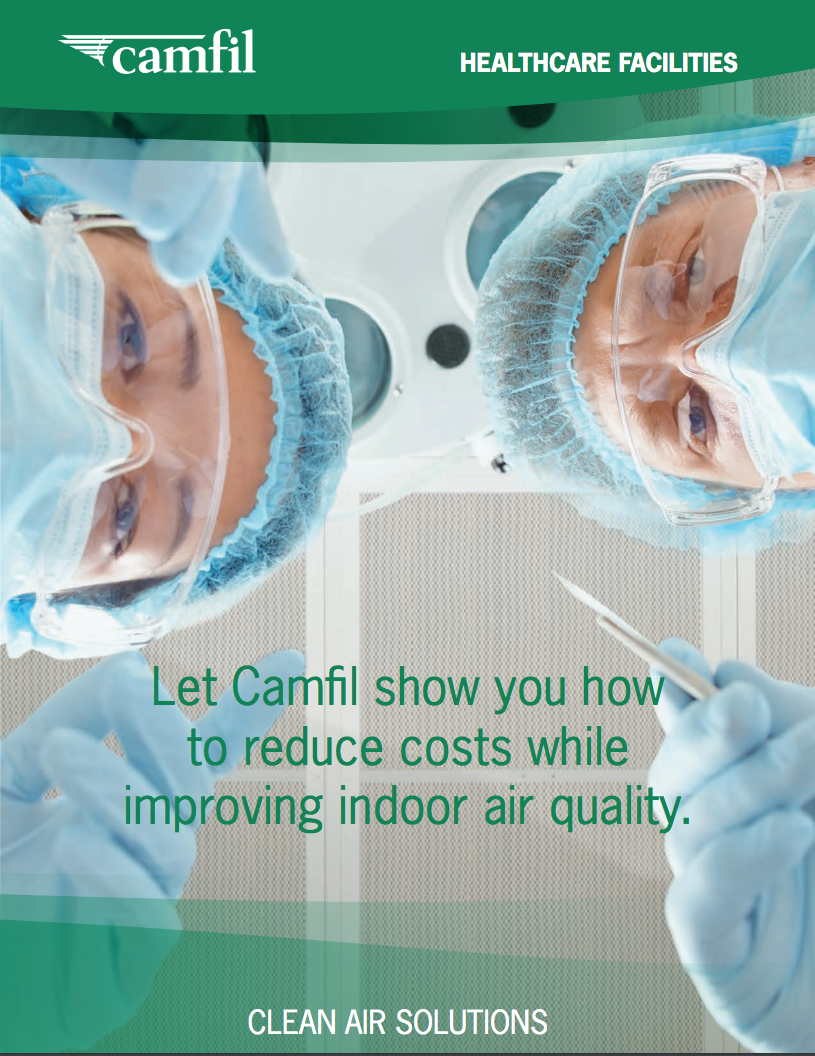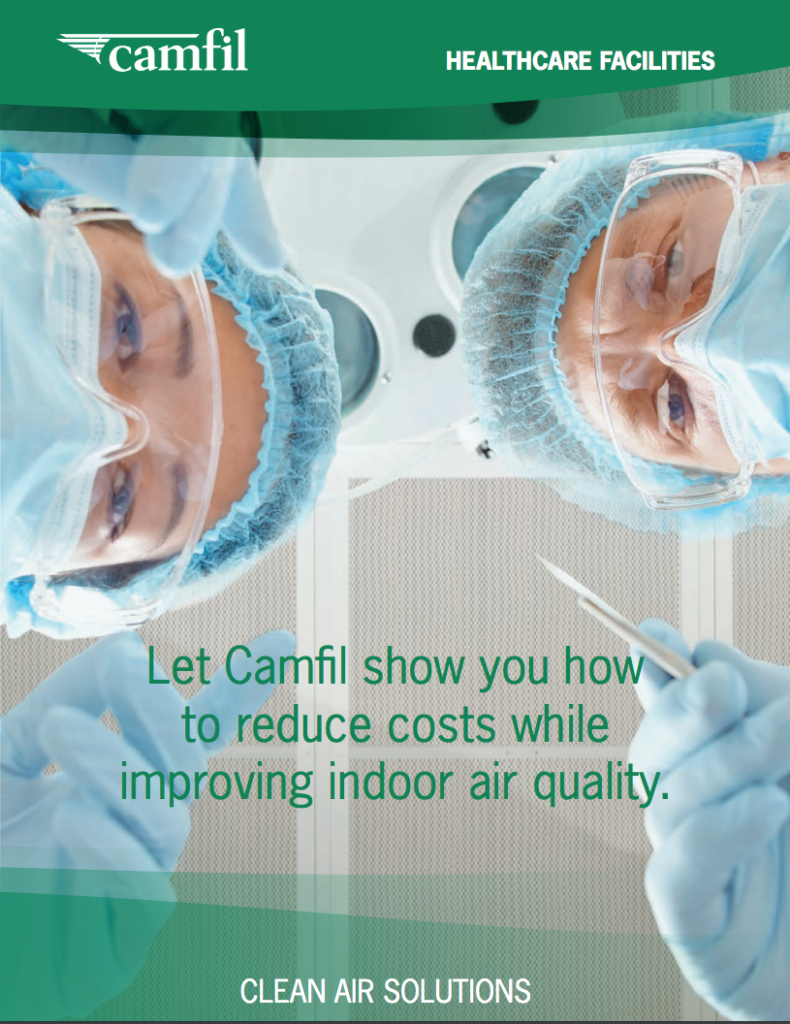Clean Air Solution by Camfil USA. Leader in Air Filters for Commercial and Industrial applications.
Learn the challenges hospitals face in improving air quality
As a place of healing and recovery, hospital air quality is even more important than the air quality at commercial offices and shopping malls. The purpose of a hospital is to return people to good health, and an essential aspect of this process is ensuring that airborne pollutants do not make existing conditions worse.
“Well we know from our research that many hospitals are struggling with their budgets,” stated Dave Blackwell , Healthcare Business Segment Manager . “As a result, these facilities are installing low-cost air filters that are not providing the kind of return-on-investment that is ideal, and worse yet, these filters are not eliminating the kind of pollutants that are a clear and present danger to patients and hospital workers. This issue was serious enough that ASHRAE Standard 52.2 was recently amended to require manufacturers to test all MERV rated air filters, including hospital air filters. Simply put, hospitals should demand ASHRAE test reports be supplied by their supplier.
Main Challenges to Hospital Air Quality
The biggest reason that hospitals are forced to spend more on air quality is that these facilities face greater pollutant challenges than other enclosed spaces.
Per an article on the Consulting-Specifying Engineer website, (1) patients and hospital workers are two significant factors in hospital air quality.
Because hospitals are filled with patients who have a variety of ailments, there is a much higher likelihood that some of these patients can release infectious contaminants that can impact indoor air quality.
For example, per an article in Healthline, (2) a recent study by researchers at Massachusetts Institute of Technology that was published in the Journal of Fluid Mechanics found that coughs and sneezes can travel 200 times further than what scientists had thought.
Most scientists agreed that the cloud of infectious pollutants in a cough could travel 200 feet, but the new study found that “droplets 100 micrometers in diameter can travel five times farther than previously estimated, that droplets 10 micrometers in diameter can travel 200 times farther, and that droplets less than 50 micrometers in size can remain airborne long enough to reach ceiling ventilation units.”
The study was important in terms of understanding how airborne pollutants within a hospital can compromise air quality and lead to infectious outbreaks.
Lydia Bourouiba, the author of the study and an Assistant Professor at MIT’s Department of Civil and Environmental Engineering stated:
“This can all help target and improve mitigations strategies such as spacing between patients in hospitals, air ventilation and filtration in confined spaces.”
But for medical officials to implement an effective air filtration strategy, they must have sufficient resources, which more often than not, is all about money.
Budgeting Effects on Hospital Air Quality
There’s been a lot of news lately about the number of public hospitals that are facing extreme state budget cuts and changes in how Medicaid reimburses them for treating patients.
And while this may seem tangential to hospital air quality, it drives at the heart of the funding crises that has forced many health care officials to use lower-cost air filters that do not have the capacity to eliminate the most harmful particulates that can affect patient and worker health.
In addition, many hospitals are burdened by the amount of money they have to spend on patients who are admitted with respiratory illnesses directly tied to air pollution.
But a recent study published on the Rand Corporation website (3) has found that insurance companies such as Medicare and hospitals could actually reduce their spending on acute care if they focused on reducing the overall level of air pollution.
The study tracked the number of pollution related hospital events at five California hospitals from 2005 to 2007, and determined that both hospitals and health care insurers would have saved significant money on caring for patients with pollution-related ailments if they had helped the state meet federal clean air standards.
Per the article:
“Meeting federal clean air standards would have prevented an estimated 29,808 hospital admissions and ER visits throughout California…Nearly three-quarters of the potentially prevented events are attributable to reductions in ambient levels of fine particulate matter, that is, particulate matter with an aerodynamic diameter of less than or equal to 2.5 micrometers [PM 2.5].”
Translated into raw numbers, the failure to meet clean air standards cost health care insurers $193,100,184 during the two-year time-period of the study.
That means that improved air quality would have eliminated nearly $194 million in health care spending, not just for insurers, but also for the hospitals that were burdened with patients in need of acute care for these pollution-related illnesses.
And while this is just one study on the problem, it’s clear that any push to reduce outdoor pollution will have a positive net effect on indoor air quality at many hospitals, thereby reducing expenses and helping to focus more resources on air filtration.
And speaking of saving money………Energy efficient, long –life air filters can reduce energy spend for your hospital’s HVAC system and cut installation labor costs by 2-3 times. Most hospitals don’t realize that high quality air filters can save more than they cost.
Air Filters

For more than 50 years, Camfil has designed air filters specifically designed for hospital rooms and operating areas.
Please visit Camfil.us more information about clean air solutions designed for hospitals and other medical facilities.
Lynne Laake
Camfil USA Air Filters
T: 888.599.6620,
E:Lynne.Laake@camfil.com
F: Friend Camfil USA on Facebook
T: Follow Camfil USA on Twitter
Y: Watch Camfil Videos on YouTube
SOURCES
- http://www.csemag.com/single-article/indoor-air-quality-in-hospitals/b4a355bfbd61c4902f08216c20be3e8e.html
- http://www.healthline.com/health-news/coughs-and-sneezes-send-particles-far-041314
- https://www.rand.org/pubs/periodicals/health-quarterly/issues/v2/n3/06.html
The post Hospital Air Quality Matters – Learn Data from Camfil Report appeared first on Air Filters for Clean Air .

